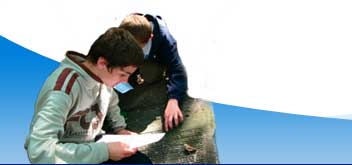Every teacher knows that an organized trip with the students should be for them both an occasion to relax, and to learn something in a less formal way. So how can this be the case when dealing with such a difficult subject as the Holocaust? It turns out it is possible. The students of the second class of the Middle Schol No. 4 in Czerwionka-Leszczyny were invited to participate in a project, which involved planning and organizing a bicycle trip on the very same 24 km long route that 62 years ago the prisoners of Auschwitz concentration camp were forced to march. During the trip the students were supposed to visit the places of memory and prepare both photographic and written material, then include it in their reportage, using maps as well as the source texts (relations of the surviving prisoners). The following text is one of the awarded reportages made by students who participated in the trip.
September 22nd, 2006. The sun rose at 5:41 AM. Cloudless sky, and a delicate breeze, it looks like a great day for a class field trip! Almost all students of the IIB class showed up at the gates of the Gymnasium at 8:30. Our fascinating adventure with the history was started by our indispensable history teacher, Mrs Malgorzata Mazur-Zajac, joined by the Polish language teacher Mrs Malgorzata Pyszny and the English language teacher, Mrs Alina Wozniak.To avoid getting lost we were given maps of our parish. Our history teacher decided to make our trip more interesting by, from time to time, taking out of mystery envelopes the stories of the Jewish survivors of the Holocaust, whose tracks we were supposed to follow.
Account of Shalom Lindenbaum, 19:
January 18th, 1945We’ve been walking the entire night and it wasn’t until morning that we were allowed to rest a bit in some brickyard, on the left side of the road. There we left the dead and those who have frozen to death during the stay. People who were too exhausted to march were shot by the guards. I myself wanted to put an end to my misery at some time, for I was so tired, that I didn’t care about anything anymore. I just sat down near the road. My father saved me then, begging me to stand up and move on, saying that the city of Gliwice was not far away. I wasn’t too convinced, so he dragged me, asking if I wanted to ever see my mom again. And in that way, by sheer force and the promise of seeing my mother, my father managed to put me on my feet. This evening we reached Gliwice. On the 21st of January the prisoners were forced to march to the cargo train station in Gliwice, where the open coal wagons were already waiting. Each wagon was loaded with 100-150 people. After the doors were closed, some more people were thrown in over the boards. Since it was impossible to leave the wagon, the prisoners had to relieve themselves where they stood and throw the body’s wastes out over the boards with their own hands. The train went through Makoszowa, Gieraltowice, Knurow, and Szczyglowice before stopping in Rzedowka, 8 km from the city of Rybnik. We have left the school, fully aware that we were not alone; the shadows of the prisoners of Auschwitz extermination camp were our company. Following the Kombatantow Street, then Wolnosci Street, we went near the dam and a huge tree with its terror-striking hornets.
We were riding through Nowy Dwór, with its prewar houses in ruins. Some of the girls suffered from short breath on this ghostly route, and it was just a beginning of our trip! We went on by Pojdy Street and we reached the place where the second mystery envelope was opened and read. For the inquisitive readers’ minds, the place in question was called Leszczyny-Rzedowka. To understand the importance of this place one must recall the history of the World War II. In January 1945, during the evacuation of the extermination camp in Auschwitz, 288 prisoners of the camp were executed near the train station in Rzedowka. The bodies were buried in a mass grave near the railway. In May 1958 the remains of the victims were exhumed and moved to the cemetery in Gliwice. In 1966 a monument commemorating the murdered prisoners was erected in Leszczyny, near the train station.
Account of Alfred Kaluza, 14, inhabitant of Rzedowka:
At night I heard moans and shooting coming from the train station. On the morning I went with others to see what was happening. At the ramp, where usually the wood from the nearby forests was loaded, I saw a parked train with steam locomotive and open coal wagons. The prisoners wearing striped uniforms were standing in the wagons and the escort, composed of uniformed guards, was walking around the train, as if waiting for something. The commanding officer of the local police post was arguing with the train guards. Many prisoners were trying to escape from the wagons to the nearby forest. The 5 minutes we’ve spent contemplating this story near the monument were for us a time of reflection and meditation. But since we don’t want to have the readers think that our group suffered from depression all the time, we allow ourselves to describe some lighter points of this journey as well. Our fellow student Damian M. paid tribute to the victims by lighting up a handle on the monument, this moment might be seen on the picture. Our history teacher told us about a beautiful Jewish tradition of placing the small stones on the graves instead of flowers or candles.
And so we did. The story of the murdered prisoners is also commemorated by the memorial cross standing nearby.
It was time to move on, and we took the street of Arki Bozka and we rode to Kamien. Sitting on a stone bank (with teacher’s permission) we listened to one more story from the mystery envelope. It was another moment of sorrow and meditation. Everything becomes of secondary importance when one starts thinking about the past.
On the next stage of our trip we stopped at the cemetery in Ksiaznice, where a grave of the victims of the Death March is located. The road to the cemetery led us through a beautiful forest. We all stood at the grave, on which the camp numbers of the Auschwitz prisoners (45 of them) were engraved. Our history teacher read us another heart taking relation. The monument expresses the respect and memory of the inhabitants of Ksiazenice toward the victims of Auschwitz camp. Another stage of our journey. Riding through the impassable bush (unfortunately we don’t recall the wood’s name) we found by hazard a frozen food wholesale. Then the last envelope was opened. The faces and nervous giggling of the students were proof of their attention for the story, which was immediately read while we were enjoying the delicious ice creams sponsored by our teachers. This nice and tasty accent put an end to our extremely interesting expedition. Time to go home! In Czerwionka we said hello to our teachers and everyone went their way.
During this trip we suddenly became aware of the fact that the great tragedies of the 20th century happened not so long time ago. We feel in our hearts that the memory of our history must be nurtured and passed on to the others. That’s why we wrote this reportage. We will never walk by any monument without paying attention anymore. Written by Sandra Łaska and Vanessa Piekielnik





